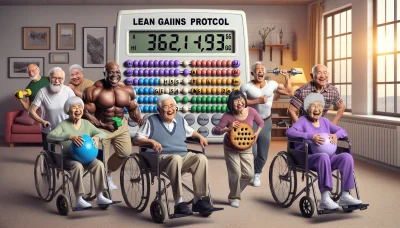Leangains intermittent fasting Quiz
Test Your Knowledge
Question of
Understanding Leangains Intermittent Fasting
The Basics of the Leangains Protocol
Leangains is a game-changer in the world of fitness and nutrition, combining intermittent fasting with a structured training regimen. It's not just a diet; it's a lifestyle that synchronizes eating patterns with workout schedules for optimal results. The brainchild of fitness expert Martin Berkhan, Leangains is tailored to those who are serious about transforming their bodies.
This protocol is all about precision and strategy. It requires strict adherence to fasting periods and careful attention to calorie intake during feeding windows. The meticulous nature of Leangains makes it incredibly effective for fat loss and muscle gain, catering specifically to those looking to sculpt their physique without compromising strength or performance.
The 16/8 Fasting Method
The cornerstone of the Leangains protocol is the 16/8 fasting method, where you fast for 16 hours and feast during an 8-hour window. This cycle promotes fat burning and muscle building by taking advantage of the body's natural hormonal fluctuations. It's not just about when you eat but also aligning food intake with your body's readiness to utilize nutrients effectively.
During the fasting window, your body shifts into a state conducive to fat oxidation, tapping into stored fat for energy. The feeding window then capitalizes on increased insulin sensitivity post-workout, driving nutrient uptake by muscles. This ebb and flow create an environment ripe for body recomposition.
Calorie Cycling and Macronutrient Ratios
Leangains isn't just about timing; it's also about what you eat. Calorie cycling plays a pivotal role, with higher intake on training days and a reduction on rest days to match energy expenditure. This approach keeps metabolism firing while providing ample fuel for workouts and recovery on demand.
Macronutrient ratios are another cornerstone of the Leangains method, emphasizing protein as king. Carbs and fats are manipulated based on workout intensity and timing, ensuring that your body gets exactly what it needs when it needs it. This macronutrient dance is crucial for maintaining muscle mass while shedding unwanted fat.
Benefits of Leangains for Weight Management
The Leangains method delivers profound benefits for those seeking weight management solutions that don't compromise muscle mass. By leveraging the body's natural hormonal rhythms through intermittent fasting, individuals experience sustainable fat loss while maintaining or even gaining lean muscle tissuea holy grail scenario in the fitness world.
This approach goes beyond aesthetics; it catalyzes a shift in body composition that can significantly impact overall health and well-being. With its focus on structured eating patterns and nutrient timing, Leangains fosters a disciplined relationship with food that can have lasting effects on dietary habits.
Fat Loss and Muscle Preservation
Fat loss without muscle wastage is the standout benefit of the Leangains protocol. This method harnesses the power of intermittent fasting to target fat stores directly while preserving hard-earned muscle mass. It's an ideal strategy for those looking to achieve a lean, muscular physique without the usual pitfalls associated with conventional dieting.
- Eat High Protein: Prioritize protein in every meal to support muscle maintenance.
- Train Hard: Combine heavy lifting sessions with the feeding window for maximum muscle retention.
- Mind Your Macros: Adjust your carb and fat intake according to workout intensity.
- Be Consistent: Stick to the fasting schedule without exceptions for best results.
- Avoid Overeating: Don't use the feeding window as an excuse to bingecalorie control is still key!
- Tune into Your Body: Listen to hunger cues and adjust meal sizes accordingly within your eating window.
- Stay Hydrated: Drink plenty of water throughout the day, especially during fasting periods.
- Rethink Rest Days: Use lower-calorie days as an opportunity for restorative practices like yoga or walking.
Metabolic Health Improvements
Beyond its impact on physique, Leangains offers significant metabolic health improvements. Intermittent fasting has been linked to better blood sugar control, improved lipid profiles, and enhanced mitochondrial efficiencyall contributing factors in reducing chronic disease risk and boosting longevity.
The synergy between fasting-induced hormonal benefits and targeted nutritional strategies positions Leangains as more than just a diet; it's a comprehensive health optimization protocol. Adopting this lifestyle can lead not only to visible changes in body composition but also to profound internal health enhancements that reverberate across every aspect of life.
Implementing Your Leangains Eating Schedule
Structuring Your Eating Windows
Embarking on the Leangains journey demands a structured approach to eating. You're not just eating at random; you're crafting an eating schedule that syncs with your circadian rhythm and workout routine. Typically, this involves an 8-hour feeding window followed by a 16-hour fast. This cycle is designed to maximize fat loss while preserving muscle mass, making it a favorite among fitness enthusiasts.
The key to success with Leangains is consistency. Align your feeding window to your daily routine for ease of adherence. For instance, if you choose a noon to 8 PM eating window, stick to it religiously. The predictability aids in regulating hunger hormones and optimizes digestion, ensuring your body knows exactly when it's time to fuel up and when it's time to burn fat.
Planning Your Meal Times
Scheduling meal times within your eating window can feel like a puzzle, but it doesn't have to be complicated. Start by breaking down the window into manageable meals that fit your lifestyletypically two or three main meals. Plan these around your workouts for maximum energy and recovery benefits. Pre- and post-workout nutrition are pivotal, so aim for balanced meals rich in protein and complex carbohydrates during these times.
Remember, meal planning is not just about what you eat but also when you eat. A common strategy is to have a larger meal post-workout when your body is primed for nutrient absorption. Outside of workout days, distribute your calorie intake evenly across meals to maintain satiety and metabolic rate throughout the day.
Adapting to Social and Work Commitments
Navigating social gatherings and work events while maintaining your Leangains schedule can be challenging but not impossible. Communication is vitalinforming friends or colleagues about your dietary approach can garner support and understanding. When attending events, look ahead at the menu options or bring along suitable snacks that fit within your eating plan.
Flexibility within reason can help maintain social bonds without derailing progress. If an event falls outside your typical eating window, consider shifting your window for that day only. Just ensure the following fasting period adjusts accordingly to maintain the 16-hour fast.
Tips for Successful Fasting Periods
- Start Gradually: If you're new to fasting, ease into longer periods gradually rather than going straight into a 16-hour fast.
- Create Distractions: Keep yourself busy during fasting periods with work, hobbies, or light exercise to take your mind off food.
- Avoid High-Calorie Beverages: Consuming calorie-laden drinks breaks the fast; stick with water, black coffee, or tea instead.
- Listen To Your Body: Pay attention to how you feel during fasting; if you experience extreme discomfort or fatigue, reassess your approach.
- Maintain Nutritional Balance: Ensure your eating windows provide all essential nutrients; don't use fasting as an excuse for poor dietary choices.
- Consistency is Key: Stick to regular fasting periods as much as possible for better long-term adherence and results.
Managing Hunger
Hunger pangs can be the most significant hurdle during fasting windows. To combat this, focus on high-fiber foods like vegetables and legumes during your last meal before fastingthey'll keep you fuller longer. Psychological strategies are also effective; remind yourself that hunger is temporary and often a sign of positive changes happening within your body.
Hydration and Beverage Choices
Staying hydrated is non-negotiable during fasting periodsit's essential for maintaining energy levels and overall health. Water should be your go-to beverage, but other zero-calorie drinks like black coffee and tea are acceptable too. They can even provide a mild appetite-suppressant effect! Just avoid sweeteners as they may trigger insulin responses and break the fast.
Workout Strategies While Fasting
Exercise Timing for Optimal Results
When you're fasting, the timing of your workouts can significantly impact your results. Exercising while fasted has been shown to help some individuals burn fat more effectively. However, it's crucial to listen to your body and understand how it responds to different workout times.
For those who prefer morning workouts, engaging in exercise after an overnight fast can potentially tap into fat reserves for energy. It's essential to start with moderate activities and gradually increase intensity as your body adapts to the fasting state.
Fasted Training vs. Fed State Training
Fasted training involves exercising when your body is not digesting or absorbing food, which can often lead to increased fat oxidation. In contrast, training in a fed state provides readily available glucose for energy, which might be preferable for high-intensity workouts or endurance training.
Choosing between fasted and fed training ultimately depends on individual goals and preferences. Some may find that they perform better with a pre-workout meal, while others may thrive on an empty stomach.
Aligning Workout Intensity with Eating Windows
When practicing intermittent fasting, aligning your workout intensity with your eating windows can help optimize performance and recovery. Low-intensity workouts like walking or yoga may be more suitable during fasting periods, while high-intensity workouts might be better suited for times when you have recently eaten.
Understanding the relationship between your eating schedule and workout routine can maximize your efforts. For example, scheduling strength training sessions shortly before breaking your fast allows for immediate post-workout nutrition.
Recovery and Nutrition Post-Workout
The post-workout phase is critical when you're fasting. Your body needs the right nutrients to repair and build muscle tissue. This becomes even more important if you've exercised in a fasted state since your body will be eager to replenish its depleted resources.
To ensure proper recovery, plan your fasting schedule so that you can consume a balanced meal soon after completing your workout. This meal should ideally contain proteins, carbohydrates, and fats to support muscle synthesis and energy replenishment.
Protein Intake and Muscle Synthesis
Protein is vital for muscle repair and growth post-exercise. Consuming protein after a workout can kickstart muscle protein synthesis, especially important if you've been working out while fasting. Aim for high-quality protein sources like lean meats, dairy products, or plant-based alternatives.
- Aim for 20-40 grams of protein post-workout to optimize muscle recovery.
- Incorporate complete proteins that provide all essential amino acids.
- If breaking fast isn't immediate, consider BCAA supplements during the workout window.
- Stay hydrated throughout your fasting period to support metabolic processes including muscle recovery.
Refueling with the Right Macronutrients
Besides protein, carbs play a significant role in replenishing glycogen stores used up during exercise. Pairing carbs with protein after a workout can also enhance protein absorption and muscle recovery efficiency.
Fats shouldn't be overlooked either; they are essential for hormone production and nutrient absorption. Including healthy fats from sources like avocados or nuts in your post-workout meal contributes to overall recovery and satiety.
Meal Planning and Preparation
Creating Leangains-Compatible Meals
Embarking on the Leangains journey requires a strategic approach to meal planning. Crafting meals that align with this protocol means focusing on macro balancegetting the right mix of proteins, fats, and carbohydrates. It's not just about what you eat, but also when you eat it, making timing a critical component of your meal prep.
Leangains is all about maximizing muscle gain and fat loss, so every meal should be a powerhouse of nutrition. Prioritize high-quality protein sources like chicken breast, fish, or plant-based alternatives. Ensure that your fats are heart-healthy ones such as avocados or nuts, and opt for slow-digesting carbs like sweet potatoes or quinoa to fuel your workouts and recovery.
Balancing Proteins, Fats, and Carbohydrates
Achieving the perfect macronutrient balance is paramount for Leangains enthusiasts. Proteins are the building blocks of muscle repair and growth; hence they should take center stage in your meals. Fats are essential too, but they must be chosen wiselythink monounsaturated and polyunsaturated fats which support overall health. Carbohydrates are not the enemy; select complex carbs that provide sustained energy without spiking blood sugar levels.
Dialing in on your macronutrient ratios will optimize your body's response to training and fasting. A typical Leangains plate might consist of a palm-sized portion of protein, a fistful of veggies, a cupped hand of complex carbs, and a thumb-sized portion of healthy fats. This visual guide makes balancing your macros simple and effective!
Recipe Ideas for Fasting and Feeding Days
When it comes to recipes for fasting days, simplicity is key! Think lean proteins paired with fibrous vegetables that keep you feeling full longer. Smoothies packed with greens, protein powder, and seeds can be a quick nutrient-dense option to break your fast without overwhelming your digestive system.
Feeding days are your chance to refuel! After an intense workout during your feeding window, include recipes that have a higher carbohydrate content to replenish glycogen stores. A hearty chili with lean ground turkey or tofu can be both satisfying and muscle-supporting. Remember to keep an eye on portion sizes even on feeding days moderation is important!
Grocery Shopping for Intermittent Fasting
Grocery shopping with intermittent fasting in mind sets you up for success by ensuring you have all the right foods at hand when it's time to eat. Focus on whole foods that deliver maximum nutrition per caloriethis means lots of veggies, lean proteins, whole grains, nuts, seeds, and legumes. Processed foods with empty calories? Leave those on the shelf!
Planning ahead before hitting the supermarket aisles saves time and money while helping you resist temptation. Create a list based on your meal plans for the week; this way you buy exactly what you need without succumbing to unhealthy impulse purchases.
Stocking Up on Essentials
Your pantry should be stocked with fasting-friendly essentials that make meal prep a breeze. Staples like canned beans, lentils, tuna in water, whole grain rice or pasta can serve as the foundation for numerous healthy meals. Fresh produce is great but consider frozen fruits and vegetables toothey're just as nutritious and last much longer.
- Eggs: Versatile protein source perfect for any meal.
- Nuts/Seeds: Great for snacking or adding crunch to salads.
- Olive oil/Coconut oil: Healthy fats for cooking or dressings.
- Sweet Potatoes: Complex carbs that are filling and nutritious.
- Greek Yogurt: High-protein dairy option for breakfasts or snacks.
Reading Labels for Hidden Sugars
Navigating food labels is crucial when shopping for intermittent fasting-friendly groceries. Hidden sugars lurk everywhereeven in foods marketed as "healthy". Look beyond the front packaging; scrutinize ingredient lists for sugar aliases like corn syrup or anything ending in '-ose'. The fewer ingredients listed, typically the better!
Becoming label-savvy also means watching out for serving sizes which can be misleadingly small. This awareness helps manage calorie intakekey in maintaining the energy deficit required by intermittent fasting protocols like Leangains. Always double-check nutrition facts to ensure compatibility with your dietary goals!
Overcoming Common Intermittent Fasting Challenges
Dealing with Plateaus in Weight Loss
Hitting a weight loss plateau during intermittent fasting is like hitting a wallbut it's a wall you can definitely scale! Your body adapts to routines, including your diet. When you first start intermittent fasting, the pounds might fall off quickly, but over time, your metabolism adjusts. This is where innovation and persistence come into play. It's time to shake things up and reignite that fat-burning furnace!
Adjusting Caloric Intake
If your weight loss has stalled, it's crucial to reassess your caloric intake. Are you eating too much or too little? Both can sabotage your goals. Consuming fewer calories might seem counterintuitive, but it can sometimes slow down your metabolism, making weight loss more difficult. Conversely, overeating during your eating windows can negate the calorie deficit needed for weight loss. Precision is keytrack those calories and make smart adjustments!
Incorporating Varied Forms of Exercise
Your body is an adaptation machine; performing the same workouts repeatedly leads to decreased results. It's essential to mix up your exercise regimen with both cardio and strength training. Embrace the sweat! High-Intensity Interval Training (HIIT) can particularly complement intermittent fasting by boosting metabolism and fat oxidation. Keep those muscles guessing, and they'll repay you with continued progress.
Social and Lifestyle Adjustments
Intermittent fasting isn't just about changing what you eat; it's about transforming how you liveand that includes navigating the social aspects of eating. There's no need for social isolation or awkwardness just because you're on a unique dietary schedule. With a bit of planning and communication, you can maintain an active social life while sticking to your fasting regimen.
Navigating Dining Out
Dining out while intermittent fasting may seem daunting, but it doesn't have to be a minefield! Select restaurants with diverse menus that offer options aligning with your eating plan. Don't be shy about customizing orders to fit within your dietary constraintsit's quite common nowadays. Timing is everything: try scheduling social meals during your eating windows so you can enjoy without breaking fast.
- Research restaurant menus in advance.
- Plan social events around your eating windows when possible.
- Dont hesitate to request modifications to dishes.
- Stay hydratedsometimes thirst is mistaken for hunger.
- Avoid peer pressure by having a response ready about why youre not eating outside of your window.
- Enjoy non-food-related activities with friends and family.
Communicating Your Dietary Choices to Others
Talking about dietary choices can sometimes be challenging, especially when others may not understand or agree with intermittent fasting principles. Be confident and direct about your lifestyle choice without being confrontational. Educate those interested in understanding more about the benefits and reasons behind intermittent fasting. Remember, this journey is personal; respect differing views while staying true to yours.
Tracking Progress and Making Adjustments
Monitoring Body Composition Changes
Keeping an eye on body composition is pivotal when following the Leangains protocol. It's not just about the number on the scale; it's about understanding the ratio of fat to muscle. This insight allows you to tailor your approach, ensuring you're losing fat while preservingor even buildingmuscle.
Utilizing both scales and body measurements offers a comprehensive view of your progress. While weight can fluctuate due to various factors like water retention, measurements can provide a more reliable gauge of fat loss and muscle gain over time. Regular check-ins with these tools create a roadmap of your journey.
Using Scales and Body Measurements
The scale is a powerful tool, but it must be used correctly. Weighing yourself at the same time each day, preferably in the morning after using the bathroom, gives you the most consistent data. Complement this with body measurements to capture changes in body shape and composition that scales alone can't show.
Investing in a quality body fat scale can further refine your tracking efforts. These scales estimate body fat percentage using bioelectrical impedance analysis (BIA), adding another layer of detail to your progress assessments. However, remember that hydration levels and other factors can affect BIA accuracy.
The Role of Visual Progress Tracking
Visual progress tracking, such as taking regular photos or using mirror assessments, provides tangible proof of changes that numbers alone might not reveal. It's motivating to see physical transformations unfold over time. These visual records can also highlight areas that may need more focus in your training regimen.
Photos should be taken under similar conditions each timelighting, time of day, and camera anglesto ensure consistency. Comparing these images side by side can reveal subtleties not evident from day to day, offering encouragement and insight as you continue with Leangains.
Fine-Tuning Your Leangains Approach
Fine-tuning your Leangains approach is crucial for sustained progress. If results are stalling or you're finding certain aspects challenging to maintain, adjustments may be necessary. This could mean altering caloric intake or adjusting fasting windows to better fit your lifestyle and goals.
Understanding when to adjust caloric intake is essential for continuous improvement. If weight loss plateaus or you start to lose muscle mass, recalibrating your calorieseither by creating a larger deficit or increasing intake slightlycan reignite progress.
When to Adjust Caloric Intake
- *If weight loss has plateaued for more than two weeks. *When feeling consistently fatigued or weak during workouts. *In case of unanticipated weight gain. *If losing weight too quickly, risking muscle loss. *During lifestyle changes that affect daily energy expenditure. *Before and after planned diet breaks or cheat days. *Whenever there's a significant change in workout intensity or frequency. *Before hitting a new training phase that requires different nutritional support.
Tweaking Fasting Windows for Lifestyle
Your fasting window should complement your daily routine, not complicate it. If adhering to your current fasting schedule feels forced, consider shifting the hours. For instance, if evening social events make late-night eating inevitable, adjust your window to start later in the day.
Lifestyle changes such as a new job or family commitments might also necessitate modifications to your fasting schedule. The key is flexibility; Leangains should enhance your life rather than impose undue stress. Listen to your body and adapt accordingly for long-term success.
Understanding the Science Behind Fasting
Hormonal Responses to Intermittent Fasting
Fasting triggers a symphony of hormonal activity that is pivotal for metabolic health. When we fast, insulin levels drop, which facilitates fat burning and may reduce the risk of type 2 diabetes. This hormonal shift is a cornerstone in understanding how fasting benefits our bodies.
The reduced frequency of meals during intermittent fasting enhances insulin sensitivity. This means that cells respond better to insulin, efficiently taking up glucose from the blood. Improved insulin sensitivity is linked to lowered risk of obesity, diabetes, and heart disease, making it a key metabolic marker to watch!
Insulin Sensitivity and Glucose Regulation
Intermittent fasting can be a game-changer for glucose regulation. By extending the periods without food, we give our bodies a break from constant insulin secretion, thus helping maintain healthy blood sugar levels. Better glucose control is synonymous with sustained energy and reduced cravings.
Enhanced insulin sensitivity not only helps in managing weight but also guards against metabolic syndrome. It's about striking a balance too much insulin can lead to trouble, but through fasting, we can help our body find its sweet spot for optimal health.
Growth Hormone and Fat Utilization
Did you know that growth hormone spikes during fasting? Yes! This surge boosts fat loss and muscle preservation. Growth hormone works its magic by increasing lipolysis, the breakdown of fats into fatty acids which can then be used as energy, making it a fat-burning ally.
This elevation in growth hormone during fasting periods isn't just about aesthetics; it plays a crucial role in maintaining lean muscle mass and rejuvenating bodily tissues. So when we talk about burning fat and building strength, growth hormone is your body's natural booster!
Autophagy and Cellular Health Benefits
Autophagy is the body's way of cleaning out damaged cells to make way for new ones - a biological recycling program if you will. During fasting, increased autophagic activity helps clear out cellular debris, which may protect against diseases like cancer and neurodegeneration.
The longevity benefits associated with autophagy have sparked widespread interest. Through this self-cleansing mechanism activated by fasting, our cells can operate more efficiently. It's like hitting the reset button on cellular function!
The Process of Autophagy During Fasting
Fasting acts as a trigger for autophagy, starting a cleanup process that removes dysfunctional proteins and organelles from cells. Think of it as an internal tune-up that keeps your cells running smoothly.
- Start Slow: Begin with shorter fasts to allow your body to adjust.
- Stay Hydrated: Drink plenty of water throughout the day to support detoxification.
- Mind Your Nutrition: Focus on nutrient-dense foods during eating windows to maximize health benefits.
- Listen to Your Body: Pay attention to how you feel during fasting periods and adjust accordingly.
- Avoid Overexertion: Engage in light to moderate physical activity rather than intense workouts while fasting.
- Prioritize Rest: Ensure adequate sleep to support cellular repair processes.
- Consult Healthcare Providers: Talk with a healthcare professional before starting any fasting regimen, especially if you have underlying health conditions.
This biological process has been shown to contribute greatly to longevity and overall health maintenance. Its essential for repairing DNA damage and other forms of molecular damage encountered by cells daily.
Long-Term Health Implications
Fasting isn't just about short-term gains; its impact on cellular health has profound long-term implications. Regularly inducing autophagy through fasting could potentially delay aging processes and reduce susceptibility to age-related diseases.
Incorporating intermittent fasting into your lifestyle could be transformative for your long-term health. By promoting cellular repair and regeneration, fasting lays the groundwork for sustained vitalitya true investment in your future self!
Sustaining a Leangains Lifestyle Long-Term
Building Habits for Continued Success
The key to sustaining a Leangains lifestyle is developing habits that stick. Start small, focusing on one change at a time, and gradually build up your routine. This incremental approach helps to embed these habits into your daily life without feeling overwhelmed. Consistency is your ally here; make it easier by setting clear and attainable goals.
Tracking progress can be incredibly motivating. Whether it's through an app or a journal, monitoring your journey reinforces positive behavior. Celebrate the milestones, no matter how small they seem. These victories provide the momentum needed to maintain long-term success and make the Leangains lifestyle a natural part of your life.
Establishing Routines and Consistency
Routines serve as the backbone of any successful fitness regimen, and Leangains is no exception. Establish a workout schedule that fits seamlessly into your life; this ensures you're not constantly fighting against your natural rhythm. Meal planning also plays an integral roleprep in advance to avoid last-minute decisions that might not align with your goals.
Consistency in both diet and exercise is non-negotiable for maintaining the Leangains method. Create systems that make it easier to stick to your plan, like regular grocery shopping trips for healthy ingredients or setting out your workout gear the night before. A structured environment leads to habitual behavior, which in turn fosters long-term adherence.
Mindset and Motivation Techniques
- Visualize Success: Regularly envision achieving your goals. This mental imagery promotes motivation and can guide you through challenging days.
- Set Realistic Goals: Break down your overarching objectives into smaller, manageable targets to avoid feeling daunted.
- Find Your Why: Understand the deeper reasons behind your commitment to Leangains. This intrinsic motivation can carry you through when external factors wane.
- Cultivate Patience: Accept that results take time and resist the urge for quick fixes. Trust in the process and stay patient.
- Seek Support: Surround yourself with a community or individuals who share similar goals. They can provide encouragement and accountability.
Adapting Leangains as Life Changes
Life is not static, and neither should be your approach to Leangains. As circumstances shiftbe it job changes, family commitments, or simply agingit's crucial to adapt your methods accordingly. Flexibility in adjusting workout intensity or meal plans ensures that Leangains can be maintained despite life's inevitable ebb and flow.
Recognizing when to pivot strategies is vital for long-term success with Leangains. Listen to your body's signals and be willing to modify routines as needed without compromising on the fundamental principles of high-intensity training and intermittent fasting that define the program.
Managing Stress and Sleep Quality
Achieving balance in stress levels and sleep quality is essential for sustaining a Leangains lifestyle over time. Chronic stress can negatively impact weight loss efforts by affecting hormone levels while poor sleep undermines recovery from workouts and can lead to poor dietary choices due to increased hunger hormones.
To combat these challenges, prioritize stress management techniques such as meditation or deep breathing exercises, along with establishing a consistent sleep schedule. These practices support overall well-being, which in turn helps maintain the discipline required for Leangains.
Adjusting for Age and Metabolic Shifts
As we age, our metabolism naturally slows down, necessitating adjustments in our diet and exercise routines. It's important to acknowledge these shifts rather than fight against them when following a Leangains lifestyle long-term. This might mean recalibrating calorie intake or tweaking macronutrient ratios to align with changing metabolic demands.
Incorporating resistance training is especially important as one gets older because it helps maintain muscle massa key factor in keeping metabolism active. Adjustments should be made thoughtfully, always focusing on what feels sustainable for your body's needs at any given stage of life.












